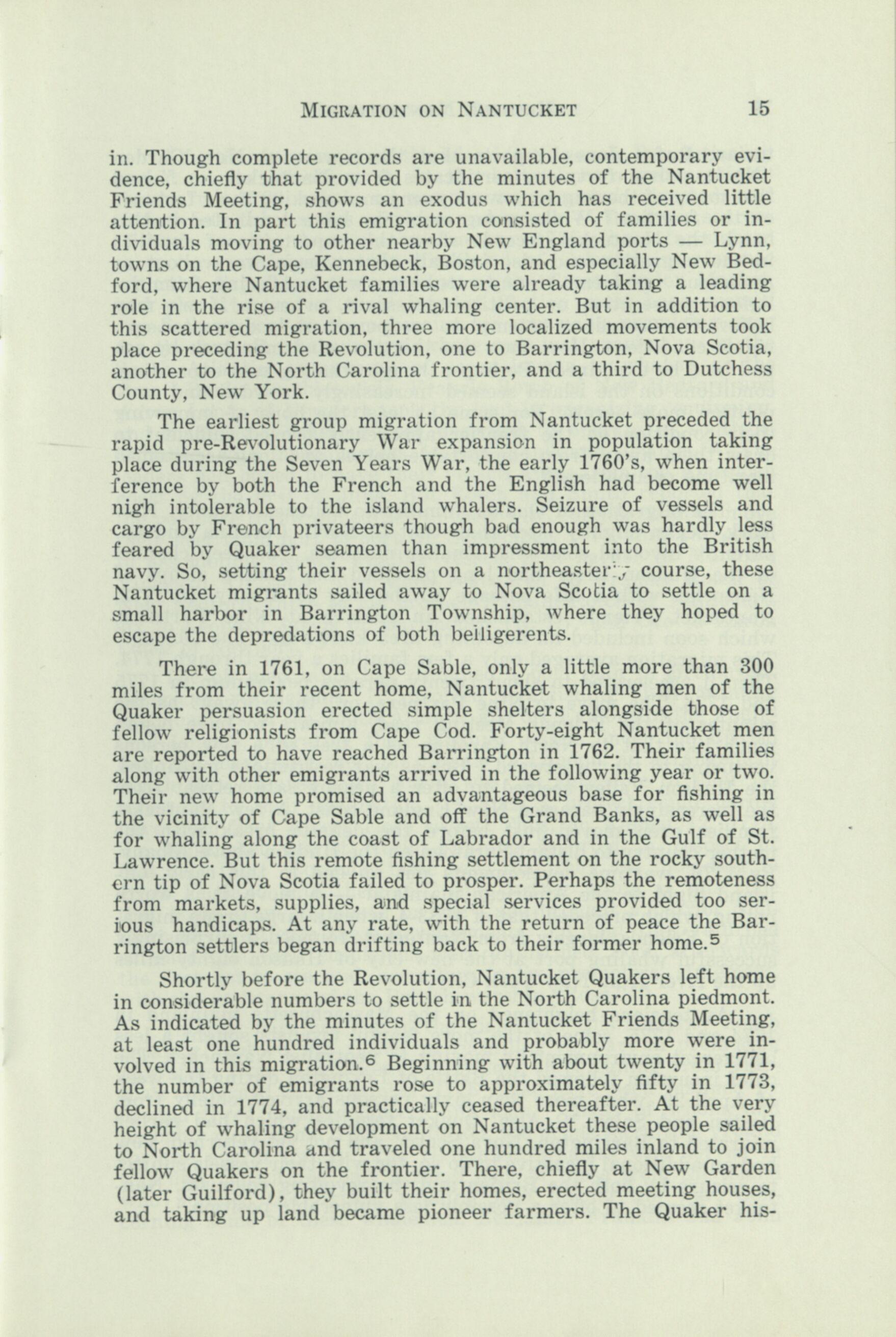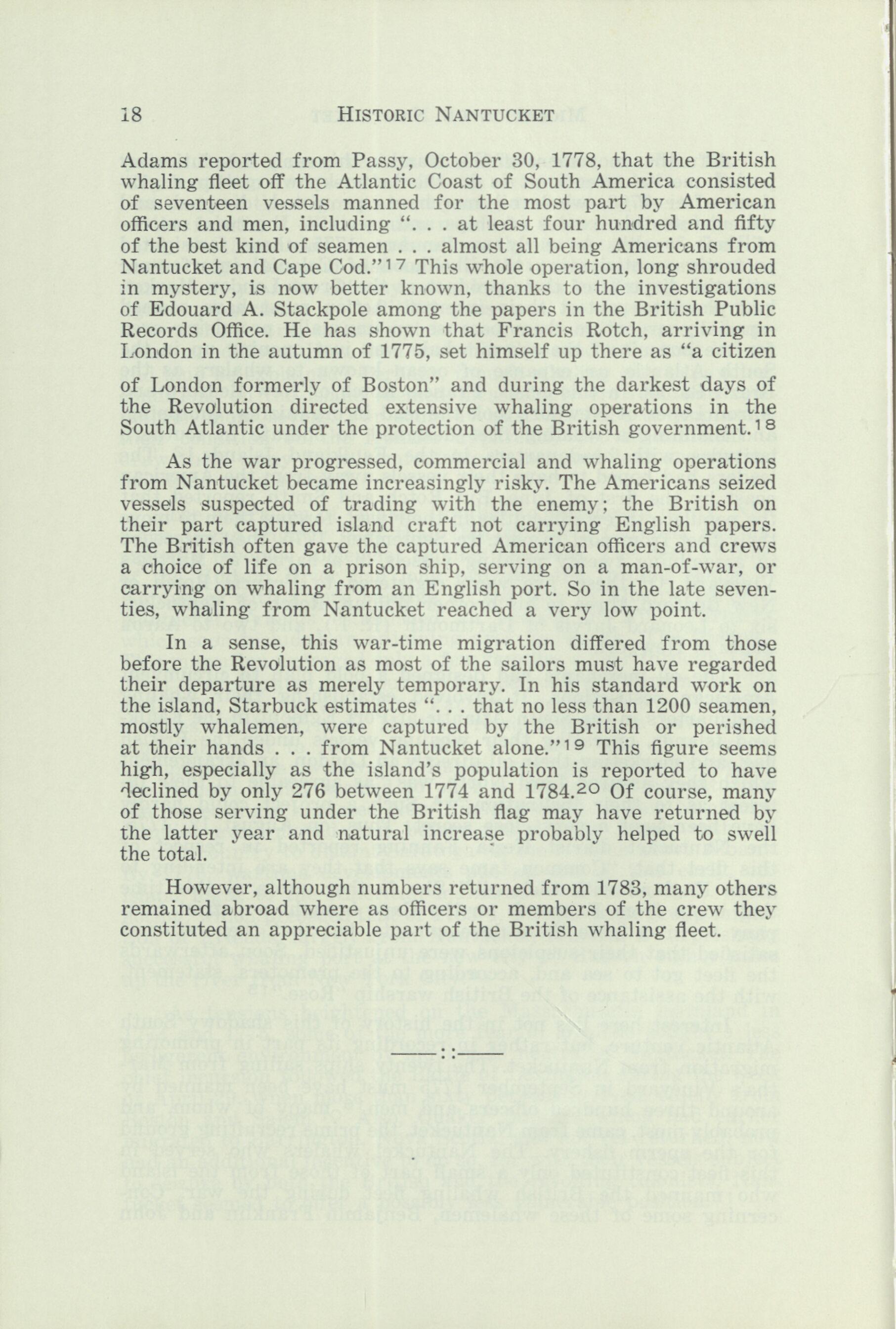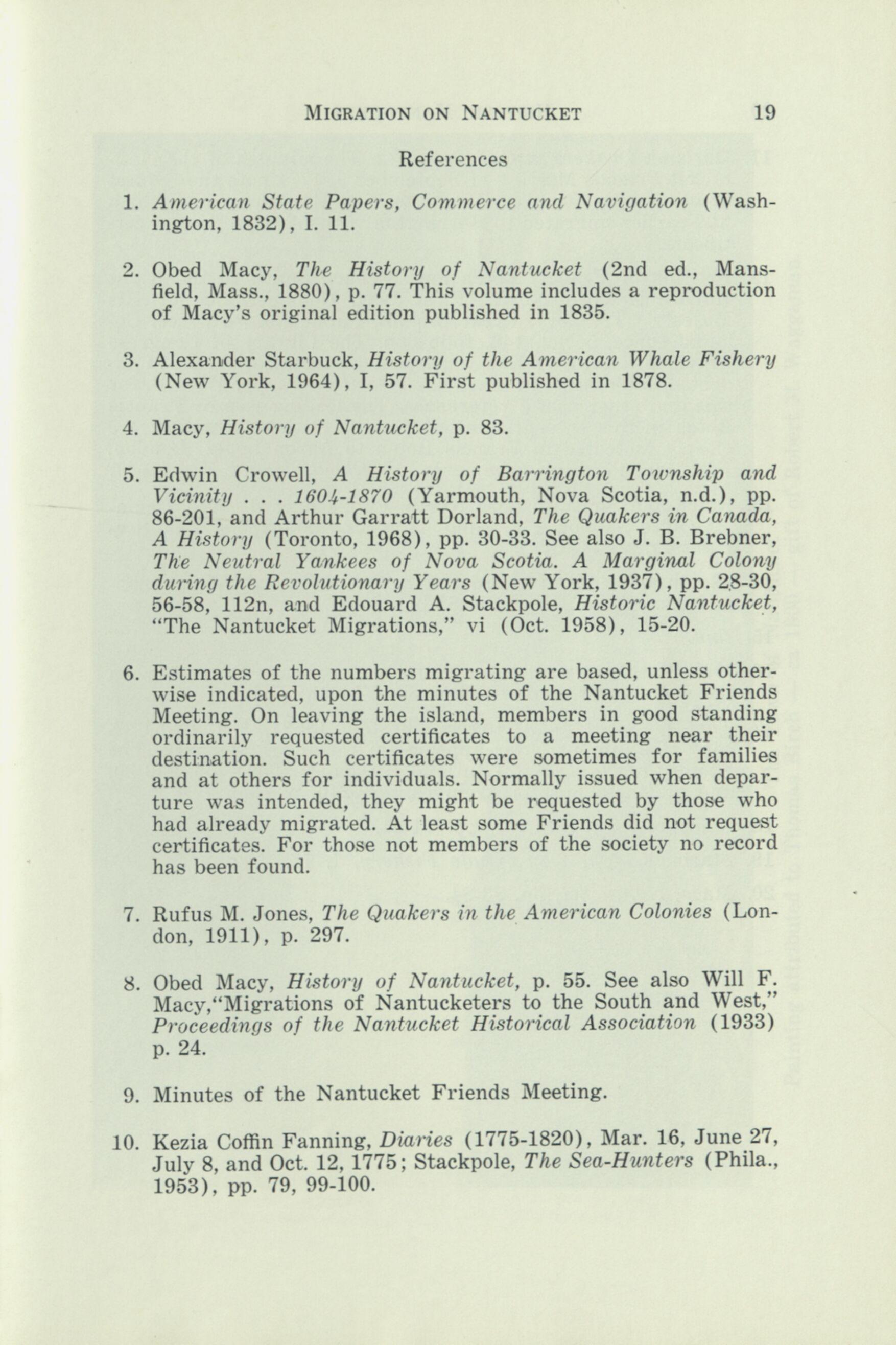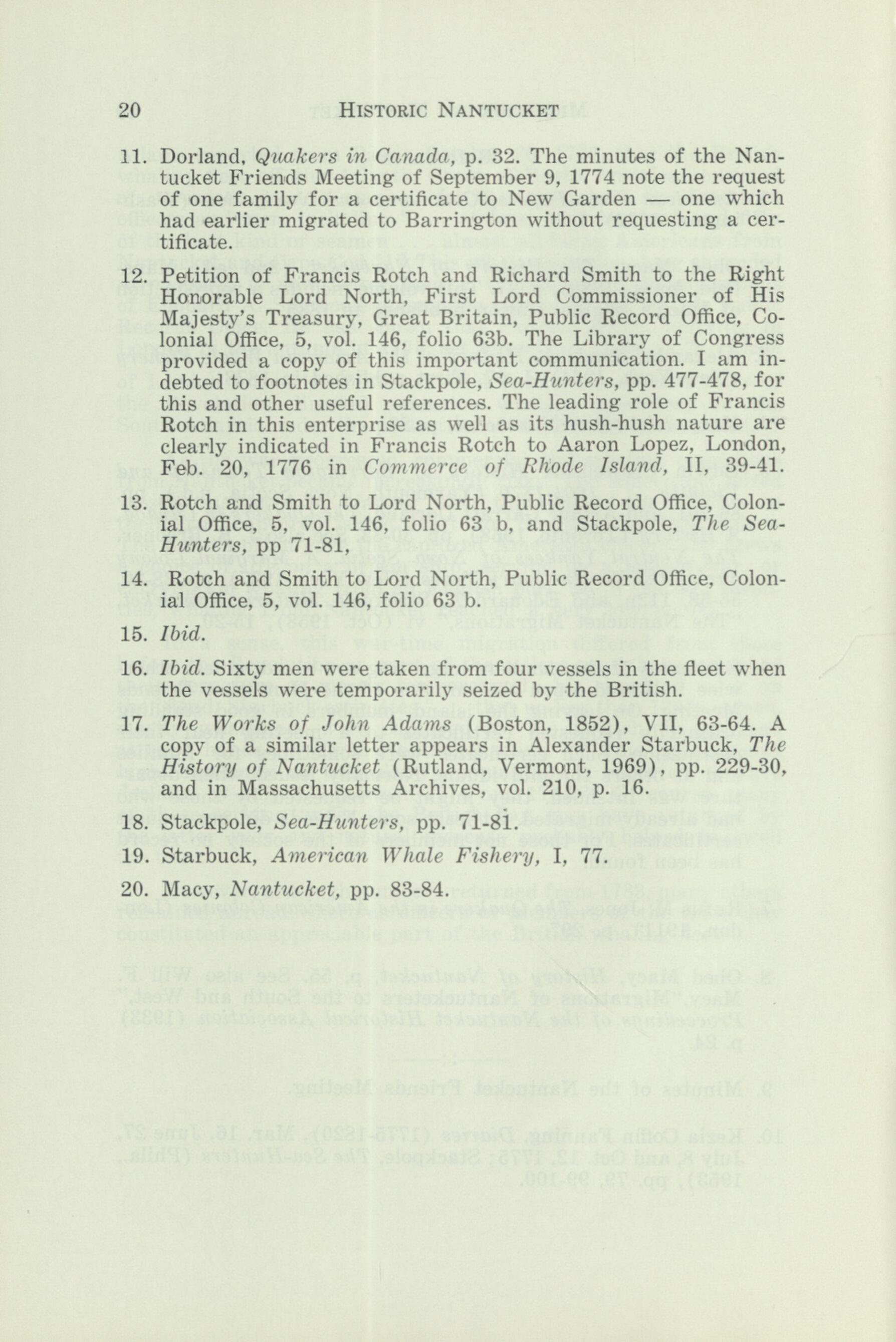
14 minute read
Currents of Migration on Nantucket
14
Currents of Migration oil Nantucket 1760 - 1780
BY GEORGE ROGERS TAYLOR
THE PATTERN of migration to and from the island of Nantucket in the late Colonial Period departs from the familiar New England model. The over-all view is that of a rapidly multiplying people engaged in cultivating a thin and soon-exhausted soil who provided the pressure for a persistent exodus which surged westward from the coastal and rural towns of southeastern New England into western Connecticut and Massachusetts, across the border into New York and Pennsylvania, and northward into New Hampshire and Vermont.
On the other hand, the infertile soil of Nantucket never held out to settlers the hope of rich harvests promised by the river valleys and forest-clad hills of the mainland. In 1791 Thomas Jefferson described the island of Nantucket as "a sand bar fifteen miles long, and three broad."1 The pulling power of Nantucket lay in its preeminence as the leading whaling center in the colonies. Voyaging for whales and the related mercantile, servicing, and processing operations provided almost the only employment. Especially in the ten years just before the Revolution, whaling attracted an increasing flow of immigrants to Nantucket. Leading island authorities testify to the unprecedented expansion of the industry. Obed Macy reported that whaling in the American Colonies in the period 1770-1775 "increased to an extent hitherto unparalleled."2 And Alexander Starbuck declared that whaling in the colonies in 1774 was "in the full tide of success."3 Nantucket, possessing roughly half of the industry in the British Colonies, shared richly in this growth.
A remarkable acceleration in Nantucket's population growth during the ten years before the Revolution reflects the contemporary boom in whaling. From 1726 to 1764 the average decennial increase had been a little over 575 persons. Then during the ten years ending in 1774 the number of inhabitants rose 1352 to total 4545.4 This increase of more than forty per cent in ten years on this isolated stretch of sand constituted a small scale population explosion. In the colony of Massachusetts when the war began, only Boston with 16,000 people and Salem with 5,337 were larger. Nantucket's sister island, Martha's Vineyard, though more than twice her size and with several harbors as good or better than that of Sherburne (later Nantucket Town), could claim a population of little more than half that of Nantucket.
In the years preceding the Revolution, when whaling was becoming so prosperous and Nantucket's population growing so rapidly, a considerable conntermovement from the island set
MIGRATION ON NANTUCKET 15
in. Though complete records are unavailable, contemporary evidence, chiefly that provided by the minutes of the Nantucket Friends Meeting, shows an exodus which has received little attention. In part this emigration consisted of families or individuals moving to other nearby New England ports — Lynn, towns on the Cape, Kennebeck, Boston, and especially New Bedford, where Nantucket families were already taking a leading role in the rise of a rival whaling center. But in addition to this scattered migration, three more localized movements took place preceding the Revolution, one to Barrington, Nova Scotia, another to the North Carolina frontier, and a third to Dutchess County, New York.
The earliest group migration from Nantucket preceded the rapid pre-Revolutionary War expansion in population taking place during the Seven Years War, the early 1760's, when interference by both the French and the English had become well nigh intolerable to the island whalers. Seizure of vessels and cargo by French privateers though bad enough was hardly less feared by Quaker seamen than impressment into the British navy. So, setting their vessels on a northeaster'/ course, these Nantucket migrants sailed away to Nova Scotia to settle on a small harbor in Barrington Township, where they hoped to escape the depredations of both belligerents.
There in 1761, on Cape Sable, only a little more than 300 miles from their recent home, Nantucket whaling men of the Quaker persuasion erected simple shelters alongside those of fellow religionists from Cape Cod. Forty-eight Nantucket men are reported to have reached Barrington in 1762. Their families along with other emigrants arrived in the following year or two. Their new home promised an advantageous base for fishing in the vicinity of Cape Sable and off the Grand Banks, as well as for whaling along the coast of Labrador and in the Gulf of St. Lawrence. But this remote fishing settlement on the rocky southern tip of Nova Scotia failed to prosper. Perhaps the remoteness from markets, supplies, and special services provided too serious handicaps. At any rate, with the return of peace the Barrington settlers began drifting back to their former home.5
Shortly before the Revolution, Nantucket Quakers left home in considerable numbers to settle in the North Carolina piedmont. As indicated by the minutes of the Nantucket Friends Meeting, at least one hundred individuals and probably more were involved in this migration.6 Beginning with about twenty in 1771, the number of emigrants rose to approximately fifty in 1773, declined in 1774, and practically ceased thereafter. At the very height of whaling development on Nantucket these people sailed to North Carolina and traveled one hundred miles inland to join fellow Quakers on the frontier. There, chiefly at New Garden (later Guilford), they built their homes, erected meeting houses, and taking up land became pioneer farmers. The Quaker his-

16
HISTORIC NANTUCKET
torian, Rufus Jones, reports that there were at New Garden "No less than forty-one certificates from Nantucket . . and that many of the migrants were young men seeking their fortunes on the frontier.7 While young men may have dominated in this band, the Nantucket records show the importance of families in the migration and also indicate that women were about as numerous as men. At any rate, here was no fleeing from religious persecution or political pressures, or even, if we may believe the record, an attempt to escape generally depressed economic conditions. How then can this thousand mile trek by sea and land be explained? Perhaps, though whaling was expanding, conditions on the island seemed increasingly crowded and competition more severe. For some at least the hope of improving their condition on the frontier apparently proved sufficient to draw them away from comfortable homes and long-accustomed maritime occupations.8
The migration of Quaker families to Dutchess County, New York, began slightly later than that to North Carolina and apparently involved somewhat smaller numbers. The deep channel of the Hudson River had long provided the trading sloops of Nantucket with a safe passage all the way to Albany. In 1772, Nantucket Friends established an enclave at Nine Partners, which soon included an adjoining area known as "The Oblong." This migration averaged only a few families a year through 1774. Then it accelerated to about twenty persons per annum in 1775 and 1776. The move to Nine Partners, or "there away" as the minutes of the Friends Meeting read, appears to have begun much like that to North Carolina as a trek of a few persons venturing to the "westward." But as war restrictions multiplied, the Hudson Valley seemed to offer a nearby safe retreat from the increasingly harassed New England coast. A few Nantucket families even moved just before the definite break with the mother country to distant Saratoga on the Hudson above Albany. By 1776, wartime developments put an end to this early, offisland flight to the American mainland — a move, it is worth noting, which preceded that of 1783-4, when a large group migration of Friends, largely from Nantucket, founded a surprisingly successful whaling port at the new city of Hudson eighty miles up the river from New York City.9
As tensions heightened on the Massachusetts mainland in 1774 a)nd 1775, some of the more fearful loyalists sought a less belligerent environment by moving to neutralist Nantucket. The chief incursion followed the Battle of Lexington during the week of April 29, when more than sixty persons arrived, chiefly from Boston and Salem.10 Also, Quaker families which had earlier migrated to Barrington, Nova Scotia, and not yet returned, now had an additional incentive to do so, for with their vessels subject to seizure by both the British and the revolting colonists, Nantucket seemed to offer a possibly less vulnerable position.11

MIGRATION ON NANTUCKET 17
A further movement off the island in this early Revolutionary period merits attention. As in the better-known group migrations after 17,80, whale oil merchants promoted, directed, and underwrote this exodus of ships and crews — the twin sources of their wealth. As early as January, 1775, these far-sighted promoters, anticipating the likelihood of Colonial interference with the disposal of their product at the Great London Market, laid plans to protect their interest. Action must have seemed especially urgent to them because an unusually promising area for the pursuit of the sperm whale was just opening up in the South Atlantic, an expanse of ocean known to whalers as the Brazil Banks. In this crisis, Francis Rotch of New Bedford and Aaron Lopez of Newport took the lead in organizing, equipping, and manning a whaling fleet designed to operate in southern latitudes with headquarters in the Faulkland Islands.12 The leaders had hoped to have their vessels away from the American coast by the first of June. But Rotch and Smith reported that the populace threw difficulties in their way, forcing them to move their fleet from port to port. In September, 1775, they succeeded in assembling twenty whaling vessels in a harbor at Martha's Vineyard. Of these, five were registered to Francis Rotch of New Bedford, three to his brother William Rotch of Nantucket, six to Leonard Jarvis of Dartmouth (R. I.), and two to Aaron Lopez of Newport.13
The oil merchants had designed a bold plan to circumvent American restrictions. It involved establishing their whaling headquarters in the South Atlantic at Port Egmont in the Faulkland Islands, operating their whaling vessels under the British flag, and marketing their oil directly in London, an arrangement which they assured Lord North was "as agreeable to their interest as to their inclination."14 Such a project could hardly have been kept a very close secret. Thus, on August 12, 1775, the Nantucket diarist Kezia Fanning reported in respect of this fleet that, "Common fame says that they are intending to go to England with their oil." She further wrote at this time that boats from Falmouth on the Cape brought a patriot company to investigate these developments, but that they returned satisfied that their suspicions were unjustified. Soon afterwards the fleet got to sea and, according to the promoters' statement, with the assistance of the British warship "Rose."15
Interest here lies not in the history of this shadowy South Atlantic venture, but rather in recording its part in promoting migration from Nantucket. The twenty ships sailing from Martha's Vineyard in September 1775 must have been manned by around three hundred officers and men16 many of whom, and probably most, came from Nantucket, the prime recruiting ground for the sperm fishery. The Nantucket whalers who served in this fleet constituted only a small part of those from the island who manned the British whaling fleet during the war. Concerning some of these whalemen, Benjamin Franklin and John

18
HISTORIC NANTUCKET
Adams reported from Passy, October 30, 1778, that the British whaling fleet off the Atlantic Coast of South America consisted of seventeen vessels manned for the most part by American officers and men, including . . at least four hundred and fifty of the best kind of seamen . . . almost all being Americans from Nantucket and Cape Cod."17 This whole operation, long shrouded in mystery, is now better known, thanks to the investigations of Edouard A. Stackpole among the papers in the British Public Records Office. He has shown that Francis Rotch, arriving in London in the autumn of 1775, set himself up there as "a citizen of London formerly of Boston" and during the darkest days of the Revolution directed extensive whaling operations in the South Atlantic under the protection of the British government.1 8
As the war progressed, commercial and whaling operations from Nantucket became increasingly risky. The Americans seized vessels suspected of trading with the enemy; the British on their part captured island craft not carrying English papers. The British often gave the captured American officers and crews a choice of life on a prison ship, serving on a man-of-war, or carrying on whaling from an English port. So in the late seventies, whaling from Nantucket reached a very low point.
In a sense, this war-time migration differed from those before the Revolution as most of the sailors must have regarded their departure as merely temporary. In his standard work on the island, Starbuck estimates ". . . that no less than 1200 seamen, mostly whalemen, were captured by the British or perished at their hands . . . from Nantucket alone."19 This figure seems high, especially as the island's population is reported to have declined by only 276 between 1774 and 1784.2° Of course, many of those serving under the British flag may have returned by the latter year and natural increase probably helped to swell the total.
However, although numbers returned from 1783, many others remained abroad where as officers or members of the crew they constituted an appreciable part of the British whaling fleet.

MIGRATION ON NANTUCKET 19
References
1. American State Papers, Commerce and Navigation (Washington, 1832), I. 11.
2. Obed Macy, The History of Nantucket (2nd ed., Mansfield, Mass., 1880), p. 77. This volume includes a reproduction of Macy's original edition published in 1835.
3. Alexander Starbuck, History of the American Whale Fishery (New York, 1964), I, 57. First published in 1878.
4. Macy, History of Nantucket, p. 83.
5. Edwin Crowell, A History of Barrington Toivnshig and
Vicinity . . . 160U-1870 (Yarmouth, Nova Scotia, n.d.), pp. 86-201, and Arthur Garratt Dorland, The Quakers in Canada,
A History (Toronto, 1968), pp. 30-33. See also J. B. Brebner,
The Neutral Yankees of Nova Scotia. A Marginal Colony during the Revolutionary Years (New York, 1937), pp. 28-30, 56-58, 112n, and Edouard A. Stackpole, Historic Nantucket, "The Nantucket Migrations," vi (Oct. 1958), 15-20.
6. Estimates of the numbers migrating are based, unless otherwise indicated, upon the minutes of the Nantucket Friends
Meeting. On leaving the island, members in good standing ordinarily requested certificates to a meeting near their destination. Such certificates were sometimes for families and at others for individuals. Normally issued when departure was intended, they might be requested by those who had already migrated. At least some Friends did not request certificates. For those not members of the society no record has been found.

7. Rufus M. Jones, The Quakers in the American Colonies (London, 1911), p. 297.
8. Obed Macy, History of Nantucket, p. 55. See also Will F.
Macy,"Migrations of Nantucketers to the South and West,"
Proceedings of the Nantucket Historical Association (1933) p. 24.
9. Minutes of the Nantucket Friends Meeting.
10. Kezia Coffin Fanning, Diaries (1775-1820), Mar. 16, June 27,
July 8, and Oct. 12, 1775; Stackpole, The Sea-Hunters (Phila., 1953), pp. 79, 99-100.
20 HISTORIC NANTUCKET
11. Dorland, Quakers in Canada, p. 32. The minutes of the Nantucket Friends Meeting of September 9, 1774 note the request of one family for a certificate to New Garden — one which had earlier migrated to Barrington without requesting a certificate. 12. Petition of Francis Rotch and Richard Smith to the Right
Honorable Lord North, First Lord Commissioner of His
Majesty's Treasury, Great Britain, Public Record Office, Colonial Office, 5, vol. 146, folio 63b. The Library of Congress provided a copy of this important communication. I am indebted to footnotes in Stackpole, Sea-Hunters, pp. 477-478, for this and other useful references. The leading role of Francis
Rotch in this enterprise as well as its hush-hush nature are clearly indicated in Francis Rotch to Aaron Lopez, London,
Feb. 20, 1776 in Commerce of Rhode Island, II, 39-41. 13. Rotch and Smith to Lord North, Public Record Office, Colonial Office, 5, vol. 146, folio 63 b, and Stackpole, The Sea-
Hunters, pp 71-81, 14. Rotch and Smith to Lord North, Public Record Office, Colonial Office, 5, vol. 146, folio 63 b. 15. Ibid. 16. Ibid. Sixty men were taken from four vessels in the fleet when the vessels were temporarily seized by the British. 17. The Works of John Adams (Boston, 1852), VII, 63-64. A copy of a similar letter appears in Alexander Starbuck, The
History of Nantucket (Rutland, Vermont, 1969), pp. 229-30, and in Massachusetts Archives, vol. 210, p. 16. 18. Stackpole, Sea-Hunters, pp. 71-8L 19. Starbuck, American Whale Fishery, I, 77. 20. Macy, Nantucket, pp. 83-84.










